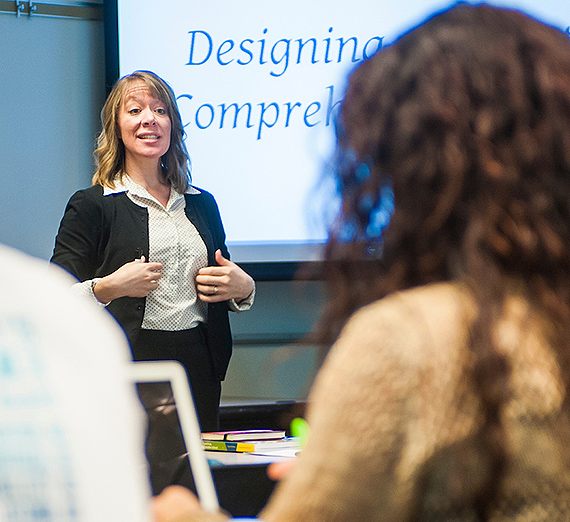Instruction Supporting Community

Candidates in teacher education are engaged in field-based instruction supported by a three-year grant that aims to ensure educational success for students at Shaw and Garry Middle Schools. The secondary education program is partnering with colleagues at Garry Middle School to achieve two parallel goals: a) Providing outstanding, field-based teacher preparation for GU teaching candidates, while b) positively impacting the academic achievement of middle school students.
The teacher education course, EDTE 221, Differential Instruction and Assessment and Field Experience takes place at Garry Middle School. Candidates meet at Garry two mornings a week with their time divided between teaching and supporting middle-schoolers and their regular course instruction, which is calibrated to reflect the real-time needs of the middle school classrooms. The 7th and 8th grade students are from diverse backgrounds and academic levels, and this program provides intense support for them to achieve grade-level competencies and beyond.
SOE faculty, Dr. Anny Case, explained that candidates and students are guided by a cadre of professionals that include faculty, cooperating teachers, site-based instructional coaches, and university supervisors. This team of mentors provides crucial support in helping our candidates develop academically and professionally. All are actively engaged in designing and providing high quality instruction for both the
GU candidates and the middle-school students.
Field placements have always been a very important part of teacher preparation, but over the past several years, the Teacher Education Department has increased the intentionality around fieldwork. These efforts are proving to be transformational for all. In the middle-school field placement, the student-adult ratio for students in the classrooms is 1 to 4. The ongoing support seems to have benefited the middle-schoolers, many of whom are exceeding their past performance in school. Additionally, the level of competency for GU candidates is greater than expected after completing this initial, intensive experience in the classroom. Being surrounded by professionals who are invested in their teacher preparation and the opportunity to make a real difference in the lives of children seem to be paying large dividends.
This new approach to secondary teacher preparation is now at a point where assessment evidence can be systematically collected as part of a research project to assess learning outcomes of both K-12 students and candidates.
The teacher education course, EDTE 221, Differential Instruction and Assessment and Field Experience takes place at Garry Middle School. Candidates meet at Garry two mornings a week with their time divided between teaching and supporting middle-schoolers and their regular course instruction, which is calibrated to reflect the real-time needs of the middle school classrooms. The 7th and 8th grade students are from diverse backgrounds and academic levels, and this program provides intense support for them to achieve grade-level competencies and beyond.
SOE faculty, Dr. Anny Case, explained that candidates and students are guided by a cadre of professionals that include faculty, cooperating teachers, site-based instructional coaches, and university supervisors. This team of mentors provides crucial support in helping our candidates develop academically and professionally. All are actively engaged in designing and providing high quality instruction for both the
GU candidates and the middle-school students.
Field placements have always been a very important part of teacher preparation, but over the past several years, the Teacher Education Department has increased the intentionality around fieldwork. These efforts are proving to be transformational for all. In the middle-school field placement, the student-adult ratio for students in the classrooms is 1 to 4. The ongoing support seems to have benefited the middle-schoolers, many of whom are exceeding their past performance in school. Additionally, the level of competency for GU candidates is greater than expected after completing this initial, intensive experience in the classroom. Being surrounded by professionals who are invested in their teacher preparation and the opportunity to make a real difference in the lives of children seem to be paying large dividends.
This new approach to secondary teacher preparation is now at a point where assessment evidence can be systematically collected as part of a research project to assess learning outcomes of both K-12 students and candidates.
